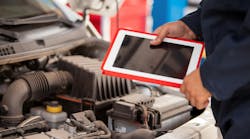Telematics, in its simplest definition, refers to the network of systems in a car that record, store and transmit vehicle data.
The term is vague and encomasses a lot because vehicles produce a tremendous amount of data. Telematics systems include everything from diagnostics and repair history to location services, user preferences and much more.
Not only are vehicles producing more data than ever, but over the last two years there has been a surge in the number of ways to access that data.
“What we see now is the vehicle manufacturers embedding telematics more in the new car build,” says Derek Kaufman, aftermarket consultant and managing partner at Schwartz Advisors. “We've seen it go from OBD-II port plug-in devices to more built-in, mobile integrated devices. That makes the data more accessible to people from their phones or whatever device they are using.”
It can be a bit overwhelming trying to figure out how to get information from a vehicle these days, much less parse through what information from a vehicle is relevant for your shop. As telematics systems become more prevalent, Kaufman says it’s becoming easier and more intuitive to make telematics work for quick lubes.
Predictive Versus Reactive
As Kaufman mentioned, one of the biggest advancements in telematics technology has been the ability to send data wirelessly. No longer do shops, dealerships, or other parties have to physically plug into a car to get even basic information.
While there is probably too much data for one shop to use all of it, Kaufman says receiving data from a customer’s vehicle before they come into a shop could be a huge boon for the quick lube industry.
“If a shop has a relationship with a customer, they can incorporate that customer’s telematics service into that relationship,” he says. “They can take the relationship from being reactive—the customer shows up for an oil change or repair—to predictive because the vehicle throws off a trouble code to the owner of that vehicle, who then chooses to send that to a shop of their choice.”
Predictive services can help significantly change how shops schedule their work, increasing efficiency and giving shops opportunities to expand their business. Kaufman says many shops have seen a significant increase in the amount of fleet work over the last several years, and being able to work with larger companies will continue to be a strong advantage moving forward.
Data Interfaces and Right to Repair
With more wireless options than ever before, Kaufman says shops are able to have some form of interface to receive data from customers’ vehicles.
“There are telematics service providers and different diagnostic platforms available,” Kaufman says. “That’s where a big problem comes in, though, because the OEMs don’t necessarily want independent shops to be in connection with their vehicles.”
The Right to Repair battle has grabbed headlines for years now, but some progress was recently made in favor of the aftermarket.
Massachusetts voters passed a more robust Right to Repair law in 2020, though that has faced some significant challenges and appeals from OEM lobbyists.
Despite those challenges, Kaufman says the fact the law passed in the first place is a sign that consumers are invested in the debate and want to have some say in it, which is good for the aftermarket.
“The people of Massachusetts have said they want the ability to own the data coming off their cars and to use that data to direct the vehicle to the service location of their choice,” Kaufman says. “That is going to be an ongoing battle between the OEMs and the independent shops, and that hand-off of information is something that is going to have to be managed.”
Kaufman says OEMs should do more than just want a better relationship, though. Each vehicle is an extension of an automaker’s reputation, and with the average age of a car now around 12.1 years old, those vehicles are outlasting their warranties by significant stretches.
As vehicles get older, Kaufman says owners are less likely to bring them into dealership or OEM-certified shops for maintenance. During the ADAPT Summit OEM panel discussion, moderator Mike Anderson of Collision Advice said that roughly 60 percent of drivers who experience an issue with a repair or maintenance on their car think it “will never be the same” and switch cars within a year or so. Of those who do switch, around 60 percent choose a different brand.
Because of that, Kaufman says it is in the OEMs’ best interest to make telematics data readily available to repairers.
“All the shops are asking is the same amount of data that a dealership has to work on a car so they can do it correctly. It’s in [the OEM’s] best interest to partner with the independent aftermarket to maintain the reputation of their brands.”
OEMs See Aftermarket as Partners
—
It’s well-known that the relationship between the aftermarket and OEMs is strained.
However, as telematics and other on-board technologies become more advanced, several major automakers have started to realize that the aftermarket is an essential component of the automotive maintenance and repair ecosystem.
“We understand that independent repairers are an extension. Our customers are your customers,” Mark Zoba, product and services planning manager for Nissan, said. “We want to make sure that shops have the information, training and tools available to make those safe and proper repairs. We want to have a better relationship.”
During the ADAPT: Automotive Technology Summit last December in Nashville, a panel of OEM representatives from Ford, General Motors, Nissan and Audi all acknowledged the importance of the aftermarket and that a healthy relationship between the aftermarket and automakers is critical for both sectors.
Each representative on the panel said his company was working toward making those repair procedures and diagnostic tools more readily available and easier to use for shops who are working on their vehicles. General Motors Aftermarket Support Manager Bob Stewart that OEMs are starting to realize the reputation of a manufacturer is ultimately on the line, regardless of who performs a repair.
“At the end of the day, these are our customers,” General Motors Aftermarket Support Manager Bob Stewart said. “At GM, safety is the No.1 priority for everything. Our vehicles need to be repaired safely and properly, and in order for that to happen, all the tools and info need to be available.”
The Bottom Line
Telematics will only continue to evolve and become more prevalent in vehicles. Even as Right to Repair battles continue to rage on across the country, Kaufman says it seems inevitable that being able to access and interpret data from vehicles will continue to become an essential part of every sector in the aftermarket.
“Fast lube, more than just about any other type of shop, depends on drive-by business. Using telematics will allow them to ... actually create a higher level of customer loyalty and a more predictive scheduling of when vehicles need an oil change.”
As consumers become more conscious of how Right to Repair affects them and as OEMs start to make the transition from seeing the aftermarket as adversaries to allies, Kaufman says that will only continue to help the aftermarket.
“Quick lube shops are going to benefit from that.”





